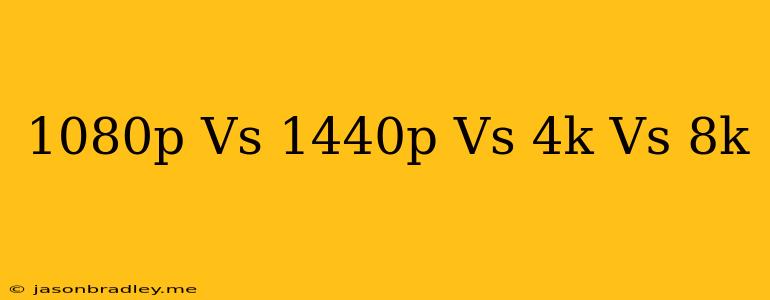Resolution Wars: 1080p vs 1440p vs 4K vs 8K
The world of displays is constantly evolving, and with it comes a constant battle for higher resolution. From the humble 1080p to the incredible 8K, the question arises: Which resolution is right for you?
To answer this, let's break down the differences and benefits of each resolution:
1080p (1920 x 1080)
- The Standard: 1080p, also known as Full HD, has been the industry standard for many years. It offers a great balance between detail and affordability.
- Pros:
- Wide Availability: 1080p content is plentiful, and most devices support it.
- Affordable: 1080p displays are typically the most budget-friendly.
- Sufficient for Smaller Screens: On smaller screens like laptops and tablets, 1080p provides a sharp and detailed picture.
- Cons:
- Limited Detail: On larger screens, like 40”+, 1080p can start to look pixelated, especially up close.
1440p (2560 x 1440)
- The Sweet Spot: 1440p, also known as Quad HD or QHD, offers a noticeable upgrade in detail and clarity over 1080p.
- Pros:
- Enhanced Detail: 1440p displays deliver a sharper, more realistic image, especially on larger screens.
- Improved Gaming Experience: 1440p is increasingly popular for gaming, offering a smoother and more immersive experience.
- Cons:
- Higher Price: 1440p displays are more expensive than 1080p displays.
- Limited Content: There is still limited content available in 1440p.
4K (3840 x 2160)
- The Ultra-High Definition Standard: 4K, also known as Ultra HD or UHD, offers four times the resolution of 1080p, resulting in incredible detail and clarity.
- Pros:
- Exceptional Clarity: 4K displays deliver stunning image quality with exceptional detail and sharpness.
- Immersive Viewing: 4K is ideal for large-screen TVs and monitors, creating a truly immersive experience.
- Cons:
- High Cost: 4K displays and content can be significantly more expensive than lower resolutions.
- Performance Demands: 4K gaming and video editing require powerful hardware for smooth performance.
8K (7680 x 4320)
- The Future of Resolution: 8K boasts four times the resolution of 4K, offering a level of detail that is almost indistinguishable from real life.
- Pros:
- Unparalleled Detail: 8K provides a level of detail that is unmatched by any other resolution.
- Future-Proofing: With the rapid advancement of technology, 8K is likely to become the standard in the coming years.
- Cons:
- Extremely High Cost: 8K displays are incredibly expensive, and content in 8K is scarce.
- Limited Adoption: 8K technology is still in its early stages and has not gained widespread adoption.
Choosing the Right Resolution
The best resolution for you depends on factors like your budget, screen size, content consumption habits, and your gaming needs.
- Casual users: 1080p will likely be sufficient for everyday tasks like browsing the web, watching videos, and casual gaming.
- Gamers and enthusiasts: 1440p offers a great balance between detail and performance, and 4K delivers a truly immersive gaming experience.
- Media professionals: 4K and 8K are essential for professional video editing and production.
Remember, technology is constantly evolving. As prices decrease and content becomes more readily available, higher resolutions like 4K and even 8K will become more accessible to the general public.
